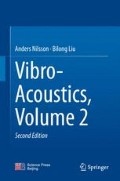Abstract
Transfer of vibrations from excitation zones to supporting and adjoining structures mainly determines noise emission from vehicles, machines, and other sources of noise.
Access this chapter
Tax calculation will be finalised at checkout
Purchases are for personal use only
Author information
Authors and Affiliations
Corresponding author
Problems
Problems
10.1
Two masses and three ideal springs are coupled as shown in Fig. 10.30. The masses 1 and 2 are excited by the forces \(F_1 e^{i\omega t}\) and \(F_2 e^{i\omega t}\), respectively. Determine the eigenfrequencies, eigenmodes, and displacement of the system.
10.2
A resilient mount is described as a simple rod. The mobilities of the rod are given by Eq. 6.96 as \(Y_{11}^s = Y_{22}^s = - i\omega / [SEk_l \tan (k_l L)]\) and \(Y_{12}^s = Y_{21}^s = - i\omega / [SEk_l \sin (k_l L)]\). Show that \(Y_{12}^s / Y_{11}^s \rightarrow 1\) as the mass of the mount tends to zero. Determine also the limiting value of \(Y_\mathrm{eq}\) as frequency or mass tends to zero.
10.3
Determine the moment mobility for a homogeneous and infinite beam.
10.4
A cylindrical and symmetric rubber mount has the point and transfer mobilities \(Y_{11} = Y_{22} \) and \(Y_{12} = Y_{21} \). A stiff mass M is mounted to each end of the rubber element. The rubber element plus the two stiff masses constitute a symmetric mount with the point and transfer mobilities \(Y_{11}^t = Y_{22}^t \) and \(Y_{12}^t = Y_{21}^t \). These quantities are measured for the complete mount, mass-rubber-mass. Determine based on these measured quantities the point and transfer mobilities \(Y_{11} = Y_{22} \) and \(Y_{12} = Y_{21} \) for the rubber mount without the masses.
10.5
A stiff mass M is mounted on a resilient mount, which in turn is mounted on an infinite steel plate with the thickness h. Determine the insertion loss of the mount as function of the plate thickness h. Model the spring as a rod, length L and wavenumber \(k_l = k_{l0} (1 - i\eta / 2)\).
10.6
A source–receiver system is shown in Fig. 10.21. The source is turned off. The point mobility of the source is measured at the coupling point between the mount and the source. This point mobility is denoted \((Y_m )_\mathrm{measured} \). In a similar way the point mobility \((Y_f )_\mathrm{measured} \) on the foundation at the coupling point between mount and foundation is measured. Determine \((Y_m )_\mathrm{measured} \) and \((Y_f )_\mathrm{measured}\).
10.7
A source–receiver system is shown in Fig. 10.21. The source is turned off. The point mobility of the source is measured at the coupling point between the mount and the source. This point mobility is denoted \((Y_m )_\mathrm{measured} \). In a similar way the point mobility \((Y_f )_\mathrm{measured} \) on the foundation at the coupling point between mount and foundation is measured. With the source in operation the velocities \(v_m \) and \(v_f\) are measured. Determine the free velocity \(v_0 \) of the source as function of the four measured properties.
10.8
Equation (10.110) gives the power input to the foundation as function of the mobility of the source \(Y^m\) and the mobility \(Y^f\) of the foundation as
Show that the maximum energy transfer from source/mass to receiver/foundation is when \(Y^f = (Y^m)^ * \).
10.9
Show that if a model is built to scale 1:Z then the frequency ratio between full scale and model scale is also 1:Z.
10.10
Use the Bishop model to determine the wavenumber for displacement along the axis of a rubber mount. Determine also \(\sigma _x\) along the axis.
Rights and permissions
Copyright information
© 2016 Science Press, Beijing and Springer-Verlag Berlin Heidelberg
About this chapter
Cite this chapter
Nilsson, A., Liu, B. (2016). Structural Coupling Between Simple Systems. In: Vibro-Acoustics, Volume 2. Springer, Berlin, Heidelberg. https://doi.org/10.1007/978-3-662-47934-6_10
Download citation
DOI: https://doi.org/10.1007/978-3-662-47934-6_10
Published:
Publisher Name: Springer, Berlin, Heidelberg
Print ISBN: 978-3-662-47933-9
Online ISBN: 978-3-662-47934-6
eBook Packages: Physics and AstronomyPhysics and Astronomy (R0)


